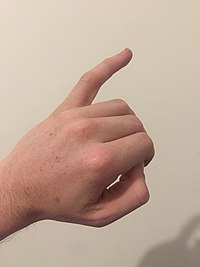
Little finger

The little finger, or pinky finger (in American English), also known as the fifth digit, or pinkie, is the most ulnar and smallest finger of the human hand, opposite the thumb, and next to the ring finger. The little finger, or pinky finger (in American English), also known as the fifth digit, or pinkie, is the most ulnar and smallest finger of the human hand, opposite the thumb, and next to the ring finger. The word 'pinky' is derived from the Dutch word pink, meaning 'little finger'. The earliest recorded use of the term pinkie is in Scotland in 1808, although the term is virtually unknown in contemporary British English, but commonplace in American English. There are nine muscles that control the fifth digit:Three in the hypothenar eminence, two extrinsic flexors, two extrinsic extensors, and two more intrinsic muscles: Note: the dorsal interossei of the hand muscles do not have an attachment to the fifth digit Among American children, a 'pinky swear' or 'pinky promise' is made when a person wraps one of their pinky fingers around another person's pinky and makes a promise. Among members of the Japanese yakuza (gangsters), the penalty for various offenses is removal of parts of the little finger (known as yubitsume). In assorted cultures, some people extend their little finger when drinking from a teacup. This practice is generally deprecated by etiquette guides as a sign of snobbery amongst the socially inferior, with various cultural theories as to the origin of the practice. The signet ring is traditionally worn on the little finger of a gentleman's left hand, a practice still common especially in the United Kingdom, Australia, and European cultures. A signet ring is considered part of the regalia of many European monarchies, and also of the Pope, with the ring always worn on the left little finger. In modern times the location of the signet ring has relaxed, with examples worn on various different fingers, although little fingers still tend to be the most usual.
